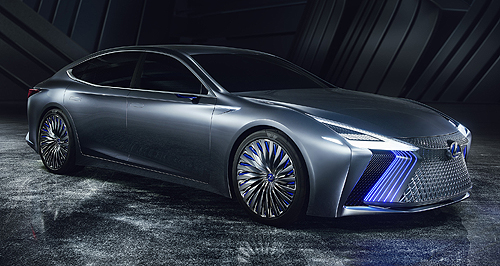Make / Model Search
Future models - Lexus - LS - LS+ ConceptTokyo show: Lexus moves forward on self-drive techNext step: Lexus describes the LS+ design as “bold yet meticulous” in terms of detail points, but the biggest changes are under the skin, where the company has ramped up its autonomous driving capabilities. Lexus LS+ concept previews forthcoming autonomous tech, styling for flagship sedanGallery Click to see larger images 25 Oct 2017 By TERRY MARTIN LEXUS has highlighted its work on automated driving technology that should become available during the lifecycle of its forthcoming fifth-generation LS flagship sedan with the unveiling of the LS+ concept at the Tokyo motor show today. Just as the Australian subsidiary of Toyota’s luxury brand is preparing to display the redesigned LS at the Melbourne Cup next month ahead of its arrival in showrooms next April, Lexus has previewed the hi-tech features and styling modifications now in development for its upper-large luxury sedan that it says are “planned for application in 2020” – about the time that the fifth-generation model is ready for a comprehensive mid-life update. The emergence of the LS+ could be a response to criticism levelled at the forthcoming new LS, which was unveiled at the Detroit motor show early this year and, although a clean-sheet redesign with a host of significant improvements, did not appear to have moved forward with autonomous driving features and other technology to the same extent as its main rivals, including the Audi A8, BMW 7 Series and Mercedes-Benz S-Class. Lexus’ move in this area also comes as Toyota likewise used its Tokyo motor show presentation to detail progress the company is making with in-vehicle connectivity and autonomous capability. In presenting the LS+ concept, Lexus International president Yoshihiro Sawa said the vehicle “combines the new potentials of Lexus design and the latest automated driving technology that we are aiming to deliver in the near future”. This autonomous capability will initially only be available on roads with suitable infrastructure and restrictions on user types (limited to motor vehicles only, for example), and is designed to enable automated merging, lane changes and diverging, as well as maintaining lane position and vehicle-to-vehicle distance. According to Lexus, the vehicle will also communicate with a data centre to update its systems’ software, allowing new functions to be added. “For advanced technologies, we aim to achieve a society in which everyone can enjoy safe, smooth and efficient mobility, particularly through automated driving technology,” Mr Sawa said. “More specifically, the concept car is equipped with ‘Highway Teammate’ which will bring automated driving on expressways in 2020. “Using automated driving technology, from the moment the car passes through the expressway entrance ramp, until it goes out of the exit ramp, the car makes proposals about junctions, overtaking preceding vehicles, and change of lanes. “The driver may approve such proposals, to enable safe and comfortable transportation to the destination.” In addition to making improvements in functionality via software updates, Mr Sawa said the company will employ artificial intelligence “that learns from the big data related to roads and surroundings to dramatically improve the car’s perceptive and decision-making capabilities”. “With such advanced technologies centring around the person that enable the car to understand the state of the driver and support him or her, Lexus will deliver cars that can be driven even more safely and comfortably,” he said. Mr Sawa added that Lexus is also developing autonomous driving capabilities for “ordinary roads”. “We will continue to evolve the technologies of the LS+ concept by working on the implementation of ‘Urban Teammate’ in the early 2020s to achieve automated driving on ordinary roads,” he said. “We will aim for an automated driving level of four or above to achieve a mobility society where everyone can move safely, smoothly and freely.” In terms of design, Mr Sawa said the concept achieves “a form that is at once progressive and dignified as an exploration of the next generation based on Lexus’ unique design philosophy L-finesse” – one that he described as “bold yet meticulous, harmonising seemingly contradictory elements”. “Moreover, we have expressed a new design language with the front and rear design, pursuing a high-level integration of imaginative technology and style elements, such as the aerodynamic and cooling performances, and the lamps,” he said. Notable additions include an evolution of the bold spindle grille, with a large shutter that contributes to both improved cooling and enhanced aerodynamic performance, along with partly laser-lit headlights and tail-lights. Electronic side mirrors also feature on the front doors. Lexus also used the Tokyo motor show to present a limited-edition RC F and GS F, commemorating the 10th anniversary of Lexus ‘F’ high-performance models.  Read more19th of October 2017  Lexus LS line-up detailed, SUV sibling wantedHybrid and twin-turbo V6 to be available in Lexus LS from launch13th of April 2017  New York show: Lexus reveals LS F Sport trimFlagship Lexus sedan to get petrol and hybrid powertrains options in F Sport trimAll future modelsLS pricing
Motor industry news |
Click to shareLexus modelsResearch Lexus All future modelsLS pricing
Motor industry news |






















 Alfa Romeo
Alfa Romeo Abarth
Abarth Audi
Audi Aston Martin
Aston Martin BMW
BMW Bentley
Bentley Ferrari
Ferrari Chevrolet
Chevrolet Ford
Ford Fiat
Fiat GWM
GWM Foton
Foton Hyundai
Hyundai Honda
Honda Jaguar
Jaguar Isuzu
Isuzu Kia
Kia Jeep
Jeep Land Rover
Land Rover Lamborghini
Lamborghini Maserati
Maserati Lexus
Lexus McLaren
McLaren Mazda
Mazda Mercedes-Benz
Mercedes-Benz Mitsubishi
Mitsubishi Mini
Mini Peugeot
Peugeot Nissan
Nissan Ram
Ram Porsche
Porsche Rolls-Royce
Rolls-Royce Smart
Smart Skoda
Skoda Suzuki
Suzuki Subaru
Subaru Toyota
Toyota Tesla
Tesla Volvo
Volvo Zeekr
Zeekr







Facebook Twitter Instagram